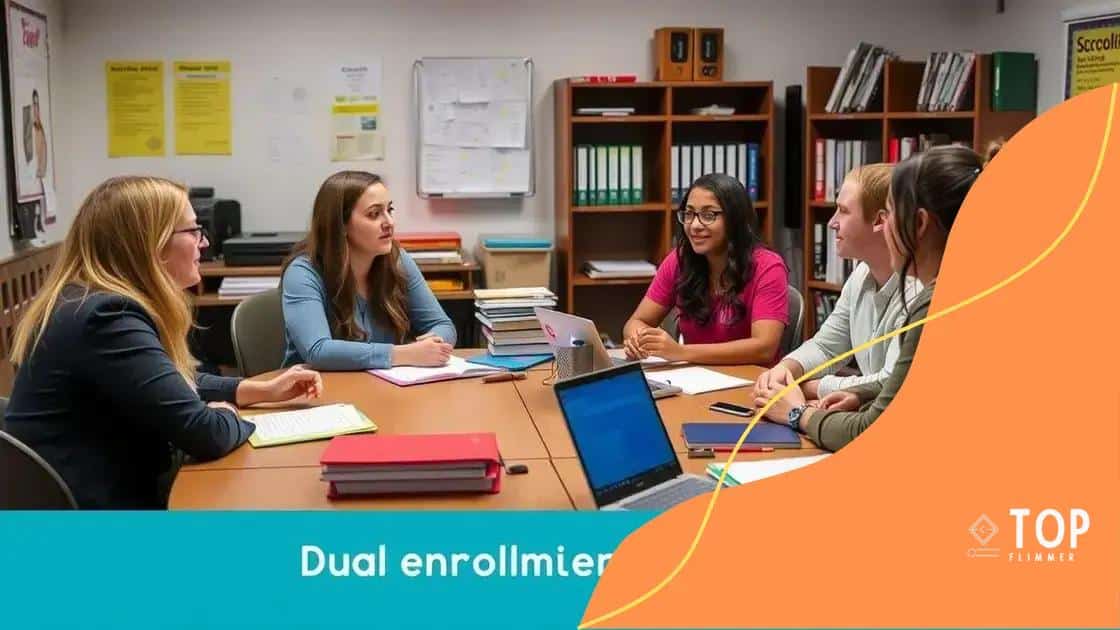Dual enrollment program standardization: benefits and insights

Dual enrollment program standardization enhances educational access and curriculum consistency, providing students with college-level coursework benefits while fostering collaboration between high schools and colleges.
Dual enrollment program standardization is gaining traction in educational circles, promising to bridge gaps between high school and college. Ever wondered how this could impact students’ futures?
Understanding dual enrollment programs
Understanding dual enrollment programs is essential for students and schools alike. These programs allow high school students to take college-level courses, offering a unique opportunity to get ahead. But what does this really mean for students?
How dual enrollment works
In a dual enrollment program, students typically attend both their high school and a local college. They can earn credits that count for both their high school diploma and a college degree. This model can provide students with a deeper insight into college life, as well as challenging coursework.
Key benefits of dual enrollment
- Access to college resources, such as libraries and tutoring
- Improved readiness for college through advanced coursework
- Potential cost savings, as college credits are often cheaper when taken during high school
- Enhanced college applications, showing commitment and capability
Students who engage in dual enrollment programs often find themselves more motivated. The experience can help develop skills that are crucial for success in both academic and professional settings. Moreover, these programs can reduce the overall time and cost needed to complete a college degree.
Colleges also appreciate the presence of students who have gone through dual enrollment. It indicates that the student is serious about their education and has already begun to prepare for the rigors of higher learning. This preparation may lead to better retention rates and graduation rates for colleges.
Challenges to consider
Though there are many advantages, there are challenges as well. Students must balance high school responsibilities with college-level expectations. This can lead to stress and potential burnout if not managed effectively. Additionally, not all courses may transfer to all colleges, so it’s vital for students to research their options before enrolling.
In conclusion, dual enrollment programs offer valuable opportunities that can greatly benefit students. By understanding these programs, students can take proactive steps towards their academic and career goals.
Key benefits of standardizing dual enrollment
Standardizing dual enrollment programs has several significant benefits for both students and educational institutions. When these programs are standardized, it creates a framework that can enhance the overall quality of education.
Improved Access to Education
One major advantage of standardizing is that it improves access for students. Uniform criteria ensure that more students across different schools can participate. This equal access can help reduce disparities in educational opportunities.
Consistency in Curriculum
- A standardized curriculum ensures that all students receive the same educational quality.
- It simplifies the process for colleges to evaluate incoming students.
- Students gain a clearer understanding of course expectations and requirements.
- This consistency can lead to better readiness for college-level work.
Another benefit is the enhancement of collaboration between high schools and colleges. When programs are standardized, teachers and administrators can work together more efficiently. They can share resources and strategies that benefit everyone involved. This collaboration helps in creating a stronger educational ecosystem, ultimately benefiting the students.
Standardization also brings clarity to the dual enrollment process. Students and parents can navigate program offerings more easily, knowing what to expect. With clearer policies, students can plan their academic futures without confusion.
Cost-Effectiveness
Furthermore, standardized programs can often lead to cost savings for both students and institutions. Schools can streamline administrative tasks, reducing overhead costs. This efficiency can translate into lower fees for students who enroll in college courses while still in high school.
Overall, the benefits of standardizing dual enrollment programs cannot be overstated. By improving access, ensuring consistency, enhancing collaboration, and increasing cost-effectiveness, these programs can better serve students and prepare them for successful futures.
Challenges in dual enrollment implementation

Implementing dual enrollment programs comes with its own set of challenges that schools and students must navigate. Understanding these challenges can help stakeholders better prepare for what lies ahead.
Managing Student Expectations
One significant challenge is managing student expectations. Many students may not realize how rigorous college-level courses can be. They might enter the program thinking it will be easy, which can lead to disappointment.
Balancing Responsibilities
- Students must balance high school commitments with college coursework.
- Time management skills are essential to succeed.
- There’s a risk of burnout due to heavy workloads.
- Students may need additional support to navigate both worlds.
Another hurdle is the alignment of curriculum between high schools and colleges. Not all high schools offer the same courses, and this can create inconsistencies in what is taught. When courses differ, it can lead to confusion for students regarding what will be expected of them.
Additionally, colleges may face challenges in evaluating students from various high schools. Differences in grading systems and course rigor can make it difficult to assess incoming students fairly. This inconsistency can hinder a student’s chances of being placed appropriately in college courses.
Training and Support for Educators
Providing adequate training and resources for educators is also crucial. Teachers often need professional development to teach college-level material effectively. Without the right tools and knowledge, educators may struggle to deliver quality instruction, which can ultimately affect student success.
Implementation of dual enrollment programs calls for ongoing communication between high schools and colleges. When both institutions work together, they can identify problems and create solutions that support students. This collaboration is essential for the growth and success of dual enrollment opportunities.
Best practices for effective standardization
Implementing best practices for effective standardization in dual enrollment programs can greatly enhance the experience for students and educational institutions. Understanding these practices is crucial for achieving optimal results.
Establish Clear Guidelines
One of the first steps is to establish clear guidelines for what dual enrollment entails. This includes defining eligibility criteria, course offerings, and credit transfer policies. When everyone involved understands the expectations, it creates a smoother process for all.
Develop Collaborative Relationships
- Foster collaboration between high school and college staff.
- Encourage regular communication to discuss student progress.
- Work together to align curriculums, ensuring both schools meet educational standards.
- Share resources for professional development among educators.
Another best practice is to focus on student support systems. Providing resources such as counseling, tutoring, and academic advising can help students navigate their dual enrollment journey. Support extends beyond academic needs; emotional and social guidance is just as important for success.
Training for educators is essential in the standardization process. Teachers need to feel equipped to deliver college-level courses. Regular professional development ensures they stay current with teaching techniques and course content. This investment in educators can lead to better student outcomes.
Utilize Data for Continuous Improvement
Employing data effectively can help make informed decisions. Collecting and analyzing data on student performance can highlight areas for improvement. This ongoing assessment allows schools to refine their programs continuously and meet the evolving needs of students.
Lastly, ensure that students and parents are informed about the opportunities and responsibilities that come with dual enrollment. Providing thorough guidance helps everyone involved understand the benefits and challenges. By doing so, institutions can build a culture of transparency and trust.
Future trends in dual enrollment education
Future trends in dual enrollment education are set to transform how students experience learning during high school. As educational needs evolve, dual enrollment programs will adapt to better serve students.
Increased Online Learning Opportunities
One notable trend is the rise of online courses. Many colleges are beginning to offer dual enrollment options through online platforms. This flexibility allows students to choose courses that fit their schedules, making it easier to balance high school and college responsibilities.
Expansion of Course Offerings
- More diverse subjects will be available, including vocational and technical courses.
- Schools may partner with local industry to provide specialized training.
- Creative programs will emerge that combine high school curriculum with real-world experience.
- Alternative assessments may replace traditional testing methods.
As technology advances, dual enrollment will likely incorporate innovative tools. Students may have access to virtual reality labs or interactive learning modules, enhancing their educational experience. These tools can make complex concepts easier to understand and engage students in a more meaningful way.
Furthermore, there will be an increased focus on personalization in education. Dual enrollment programs may use data to tailor courses to students’ individual learning styles. This approach creates a more engaging and enriching environment for students, which can lead to greater success.
Strengthened Partnerships Between Institutions
Partnerships between high schools and colleges will continue to strengthen. Together, they will develop programs that better serve local communities. These collaborations enable institutions to share resources and expertise, ensuring that all students have access to quality education.
Ultimately, as dual enrollment education continues to evolve, students can expect a more flexible, personalized, and engaging learning experience. Keeping an eye on these trends will help educators and students alike prepare for the future of education.
Conclusion
In summary, the future of dual enrollment education looks bright as it evolves to meet the needs of students. With increased online opportunities, a wider variety of courses, and improved partnerships between institutions, students can expect a more engaging and tailored educational experience. Embracing new technologies and focusing on support systems will further enhance these programs. By understanding and adapting to these trends, we can better prepare students for their academic and professional futures.
FAQ – Frequently Asked Questions about Dual Enrollment Programs
What are dual enrollment programs?
Dual enrollment programs allow high school students to take college-level courses for credit, providing a head start on their college education.
What are the benefits of dual enrollment?
Benefits include earning college credits, enhanced college readiness, and increased motivation among students.
How can students manage their time in dual enrollment?
Effective time management is essential; students should prioritize tasks, create schedules, and seek support when needed.
What future trends should we expect in dual enrollment education?
Future trends include increased online learning, more diverse course offerings, and stronger partnerships between high schools and colleges.






